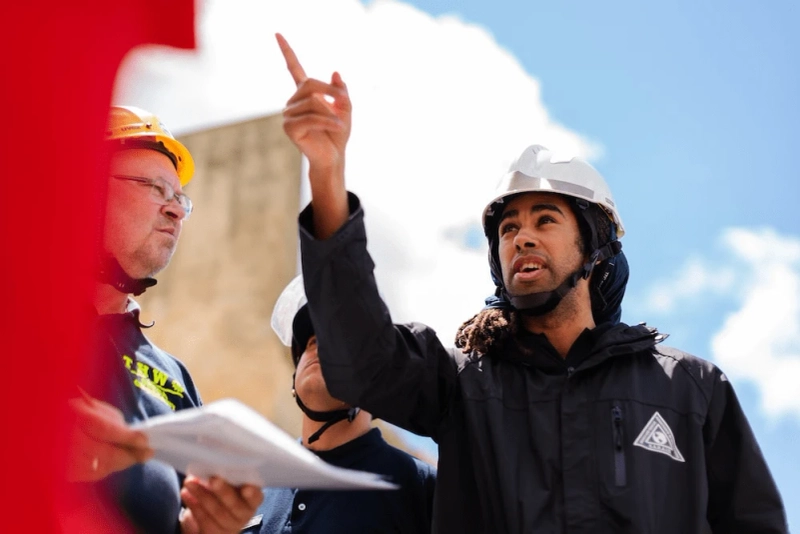Safety is not just a matter of compliance; it's a moral and operational imperative. In the construction industry, where precision, coordination, and heavy machinery intersect, the consequences of negligence can be catastrophic. From wireless crane wind speed indicators to load moment indicators, weather monitoring systems for cranes have proven quite effective in reducing the risk of fatal accidents. They help crane operators and on-ground workers predict wind direction and speed and timely halt operations in extreme weather events.
Let's underscore the significance of crane safety in harsh weather.
Operational Integrity
Ensuring the safety of crane operations is essential for maintaining operational integrity. Accidents disrupt schedules and budgets, tarnish reputations, and erode client trust.
Human Welfare
The safety of crane operators and on-ground workers is non-negotiable. The well-being of the individuals operating and working in the vicinity of cranes is paramount, and safety measures must be in place to protect them.
Legal Compliance
Regulatory bodies like OSHA and ASME have established stringent safety standards for crane operations. Non-compliance can result in severe penalties and legal consequences.
Asset Protection
Cranes are substantial investments for construction companies. Ensuring their safe operation protects these valuable assets from damage or loss.
Weather Monitoring Devices: The First Line of Defense
Adverse weather conditions pose unique challenges to crane operations. High winds, heavy rain, snow, and extreme temperatures can all affect a crane's stability and the safety of its operation. Weather monitoring devices are the first line of defense in ensuring crane safety during challenging weather. Here are some key weather monitoring technologies:
1. Crane Wind Speed Indicators
Wind is one of the most significant weather-related threats to crane stability. Crane wind speed indicators, like those offered by Crane Warning Systems Atlanta, provide real-time data on wind speed and direction. When wind speeds approach unsafe levels, these indicators issue warnings, allowing operators to take preventive measures.
2. Load Moment Indicators (LMIs)
LMIs are essential for maintaining crane stability during lifts. They calculate the load moment and display it to the operator. LMIs become even more critical in adverse weather, helping operators make informed decisions to prevent overloads and maintain stability.
Crane Operations in Challenging Weather: Dos and Don'ts
Operating cranes in adverse weather requires a heightened level of vigilance and adherence to safety protocols. Here are some dos and don'ts to ensure crane safety in challenging conditions:
Dos:
1. Monitor Weather Continuously
Stay updated on weather conditions throughout the day. Use crane wind speed indicators and other monitoring devices to track changes in wind speed, temperature, and precipitation.
2. Conduct Pre-Operation Inspections
Before each shift, thoroughly inspect the crane and all safety systems. Ensure that all weather monitoring devices are functioning correctly.
3. Adjust Load Capacities
In high winds or inclement weather, reduce the crane's load capacity to account for reduced stability. Refer to load charts and follow the manufacturer's guidelines.
4. Secure Loose Items
In windy conditions, secure all loose items on the construction site, including materials, tools, and debris. Windborne objects can pose serious hazards.
5. Use Additional Safety Measures
Consider additional safety measures, such as outrigger deployment or additional counterweights, to enhance crane stability during adverse weather.
Don'ts:
1. Ignore Weather Warnings
Never disregard weather warnings or exceed recommended wind speed limits. Ignoring these warnings can lead to accidents and equipment damage.
2. Rush Operations
Avoid rushing crane operations in an attempt to complete tasks quickly. Take the time to ensure that all safety measures are in place and that weather conditions are conducive to safe lifting.
3. Operate in Extreme Conditions
In extreme weather conditions, such as severe storms or blizzards, it's often best to suspend crane operations altogether. The safety of personnel should always be the top priority.
4. Neglect Operator Training
Ensure that crane operators are well-trained in operating cranes during adverse weather. They should be familiar with the crane's safety systems and understand the impact of weather on crane stability.
Crane Warning Systems Atlanta: Your Partner in Crane Safety
Crane Warning Systems Atlanta strives to help crane operators and managers improve on-site crane equipment safety with advanced crane warning devices. All of their products are brand-new, laced with the most cutting-edge technologies, and replete with robust surveillance systems. Whether you’re trying to enhance visibility at your crane site, boost crane operator control, or maximize crane load safety, they’ve got the right crane warning devices for you!
In addition, they also provide 24/7 on-call technical support and free-to-access crane warning device manuals, wiring diagrams, and wireless crane anemometer guides. You can also count on them to understand and choose the right RaycoWylie products. So what are you waiting for?
Get in touch with them today!
Author's Bio
This post’s author is a renowned crane safety expert in the US. He has been a regular contributor to Crane Warning Systems Atlanta’s website. He loves educating crane operators and riggers about the latest crane safety standards, warning devices, and operational practices.


